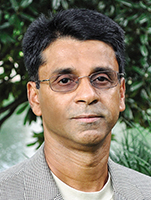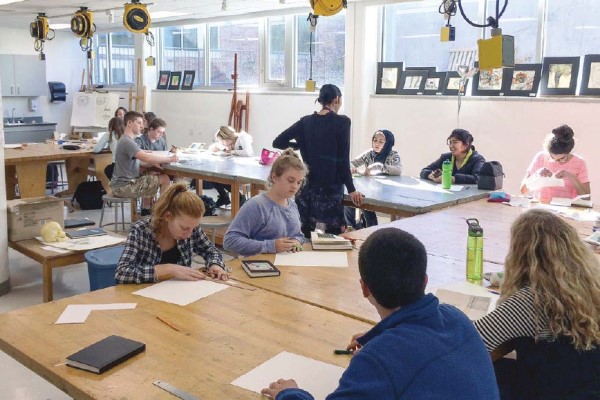Reimagining and Renovating as Acts of Choice
October 01, 2017

The Bloomfield Hills School District in Michigan had known for more than a decade that it needed to assess the capacity of its facilities to support students’ personalized learning goals. But when the district, located in a prosperous suburb outside of Detroit, talked of merging its two high schools, the community erupted in debate that showed no promise of consensus.
The total enrollment at the district’s two high schools, Andover and Lahser, had been declining for years. By not consolidating, the district would allow the two schools to continue expensive operations as their enrollments continued to grow smaller.
The school board and district leadership realized they had to evaluate their facilities and reimagine academic programming to undergird students’ individual educational pursuits. With no agreement in sight, the district asked our firm, a team of architects and educators, to step in. We engaged the community to develop a master plan that ultimately called for substantial renovation and a building addition. The outcome consolidated the two high schools into one facility on the Andover site that would feature nine distinct learning communities.
This approach satisfied the community’s desire to maintain a small school feel and the school district’s desire for an innovative and amenity-rich campus. Completed in 2015, the facility is known as Bloomfield Hills High School. It is one of the first comprehensive high schools in the United States with dedicated space for learning communities, each of which integrates core classes in a collaborative, technology-rich environment.
The 372,000-square-foot facility includes an 800-seat auditorium, a 12-lane swimming pool, three large music rooms, multiple maker spaces and labs, a multistoried art studio and a student radio station. This fall, more than 1,650 students are expected to be enrolled at Bloomfield Hills.
Competitive Arena
Reimagining and renovating public school buildings is a prevailing topic today in education. Many of the school buildings built in the 20th century are due for large-ticket replacement projects, and lower enrollments are leaving some areas, such as Bloomfield Hills, with surplus facilities.
As the new administration promotes school choice and charters amid the real possibility of diverting public tax dollars to private schools, public school districts are left wondering how they can compete in this shifting education climate. One answer is to create specialized learning programs, along with the spaces and amenities to support them.
Forward-thinking school system administrators are embarking on learning-space projects that meet these challenges in their districts and offer learners multiple learning paths to explore.

Creative Spaces
In a school district where 55 to 60 percent of the students attend charter schools, Bancroft Elementary School in Washington, D.C., was designed to support an immersive dual-language program, creating spaces specifically intended for this type of learning and thus giving the school an edge over the charters in the area. Supporting biliteracy and bilingualism, Bancroft provides its 520 students with instruction in both Spanish and English. Literacy is taught in Spanish and English; math is taught only in Spanish.
Another differentiator is the school’s NetZero status, meaning Bancroft is designed and constructed to produce as much or more energy from renewable sources than the school uses. This not only saves operating costs, it also attracts eco-conscious parents. Designing the school to be community-oriented, with interior and exterior spaces open to the public, adds to Bancroft’s local popularity.
To the north, Horace Greeley High School in Chappaqua, N.Y., is considered one of the strongest open-enrollment public high schools in the country academically, yet administrators were eager to explore learning beyond the classroom model using a Pathfinder project. Pathfinders are low-cost space renovation projects that enable teachers and students to experiment with new ways of teaching and learning without a total reconfiguration of the school facility.
To begin their exploration of creative learning spaces, the school identified 17 Innovation Fellows among their teachers to collaborate and create 21st-century curriculum units that support a student-centered, interdisciplinary and hands-on education.
Because traditional classrooms did not support this type of learning, an Innovation Lab, or iLab, was created by converting a cluster of classrooms into a technology-rich collab-orative environment. Most of the 4,000-square-foot space is open, but peppered with small tables and soft, comfortable seating, so students can work comfortably. Small glassed-in spaces are conducive to becoming discussion rooms and promoting collaboration and interactive learning.
The popularity of the iLab as a teaching and learning space has since inspired multiple innovative space changes throughout the school, including renovation of an underutilized library and a new STEAM Center. The library is now called the learning commons, with a variety of furnishings that encourage both collaboration and individual study. The addition that houses the STEAM Center will contain art and science labs along with fabrication studios and an outdoor project courtyard.
Master Plans
Districtwide commitment can promote the innovative use of student learning space. Boulder Valley Schools in Colorado, with 36 elementary schools, 19 middle schools and 14 high schools, created a master plan that stressed innovation and learning across the district. A $576.5 million bond program (which included a $20 million innovation fund) allowed the district to reinvent both facilities and curriculum.
One area the district focused on was amenity spaces — indoor and outdoor spaces that students and staff use for communal or social activities. For example, the district expanded dining areas into the “hearts” of school buildings that are used all day rather than just around noon. This is accomplished by adding more varied lighting, sound-absorbing materials and furniture options that include soft seating. It gives what used to feel like an institutional space a more inviting “coffee shop” atmosphere that is also useful for after-hour events.
The Boulder Valley district also transformed underutilized school libraries into “curiosity centers” where students can learn, think, create and explore their interests through media and physical objects, with teachers and guest experts serving as learning guides.
Using an online innovation funds tool, Boulder Valley School District personnel design customized spaces aligned to funding guidelines. The district’s $576 million bond program facilitated the space transformations across the entire district.
In the Minneapolis, Minn., School District, a lower-cost public charter school incorporated innovative programs and spaces on a smaller scale.
Venture Academy, a public charter school serving 260 students in grades 6-9, is dedicated to an individualized learning model intended to erase the gap between disadvantaged students and college or career readiness. Each student has a personalized learning dashboard on his or her laptop that guides both learning and assessment. Teachers act as coaches rather than controlling the flow of information directly.
School leaders focus on unlocking students’ passions and interests by exposing them to a variety of career paths. The school is designed to encourage creativity and independent learning. Instead of traditional classrooms, spaces support small-group learning and one-on-one tutoring. Hands-on, project-based learning takes place in the large maker space, art room and robotics lab, where specialized tools and equipment spark students’ creativity and empower their learning.
Creating Connections

These varied school district facility initiatives are not just responses to the threat of publicly funded vouchers and the heightened competition between public schools and for-profit charter schools or private schools. These imaginative uses of school spaces also illustrate better ways of engaging students in a highly connected world.
A county school district in central Virginia that has 4,400 students within 726 square miles, already stands as an exemplar of student-centered individualized learning. The district’s quest to offer even more choices for students is resulting in a new district planning project called Changing the Environment. The discussion was triggered by a series of questions, including “How would the district change if our group purpose instead became democratization of learning so that children could access time, tools, expertise and space to grow from their curiosity, interests, passion and joy?”
The vision in this countywide district is to form a local network of schools, both public and charter, to offer the most diverse degree of school choice in the nation. This series of amenity-rich environments will include many types of hands-on maker labs and will include student-designed learning spaces.
This is yet another example of how district leaders are embracing the challenge of choice, giving our public-school systems a chance to become more responsive to all students’ individual passions and goals.
Author
Advertisement
Advertisement
Advertisement
Advertisement


.png?sfvrsn=3d584f2d_3)
